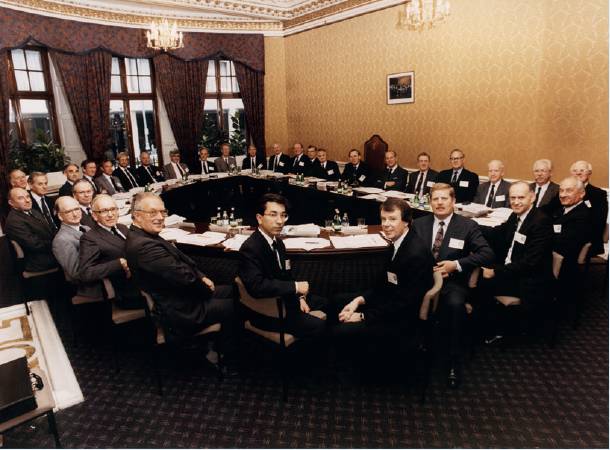Obituary
Obituary
MA MSc CEng FREng FRAeS FRSA
1932-2020
 Geoff Howell at the 34th Royal Aeronautical Society Henson and Stringfellow Lecture and Dinner at the Yeovil Branch on 16 February 1990. RAeS/NAL.
Geoff Howell at the 34th Royal Aeronautical Society Henson and Stringfellow Lecture and Dinner at the Yeovil Branch on 16 February 1990. RAeS/NAL.
After a varied and distinguished career in aeronautical research and research leadership, Geoffrey Howell died peacefully, at the age of 87, on 30 January in a care home in Wellingborough, Northamptonshire, where he had lived for the previous nine months. He was the Society’s Senior Past President.
Born on 17 July 1932 in Hammersmith, London, he was educated at Latymer Upper School and St John’s College, Cambridge. There he took first-class honours and the college prize in mathematics in his first year but by his final year had converted to mechanical sciences – the Cambridge term for engineering.
On graduation in 1955 he joined the Royal Aircraft Establishment (RAE) at Farnborough to do research on flight control. His evident ability in this field led to his promotion in 1971 to be Head of the Controls and Displays Division at Farnborough. There followed a move in 1972 to RAE Bedford to be Head of the Blind Landing Experimental Unit, which had pioneered and led the field internationally in the development of automatic all-weather landing capability.
 Geoff Howell chairs the 1,000th Council Meeting of the Royal Aeronautical Society on 30 October 1990 in the presence of The Prince Philip, Duke of Edinburgh, Hon Past-President. RAeS/NAL.
Geoff Howell chairs the 1,000th Council Meeting of the Royal Aeronautical Society on 30 October 1990 in the presence of The Prince Philip, Duke of Edinburgh, Hon Past-President. RAeS/NAL.
In 1975 he was appointed Chief Superintendent of RAE Bedford, with responsibility for both the large airfield and wind tunnel-sites before, in 1980, moving back to Farnborough to become Head of Flight Systems Department. Here his responsibility was to lead the work of a number of research divisions at Bedford and Farnborough, covering all aspects of flight control. At this time he was the national Research Area Leader in that major field of national research, responsible for the overall management of all Government-funded research in research establishments, industry and universities.
In 1982 he moved to London to the headquarters of the Ministry of Defence Procurement Executive, as Director of Aircraft Equipment and Systems. Two years later he transferred from the Ministry of Defence to the Civil Aviation Authority (CAA) to become its Director of Research. In 1988 he was appointed CAA Chief Scientist, a position he held until retirement in May 1992.
He was elected to the Council of the Society in May 1983 and, in 1988, was chosen by the members of Council to succeed Hugh Metcalfe in May 1990 as President of the Society. When he did so, he was also stepping in the footprints of another engineering graduate of St John’s College, Cambridge, Sir Charles Pringle, who was President in 1975-76 (and preceding two other Presidents who read engineering at St John’s, myself in 1996-7 and Chris Atkin in 2016-17).
Three months into his Presidential year, Iraq invaded Kuwait and in the next six months, preceding the opening of the first Gulf War, air travel reduced drastically and the economy of the air transport industry was badly hit. The negative consequences for Society activity, particularly conference attendance, room lettings and recruitment of members, were significant but the efforts of the team in No.4 Hamilton Place managed to reduce the impact. He did succeed in making a number of overseas visits, giving lectures to Divisions and Branches and promoting the Society’s aims.
At home, the highlight of his Presidential year was the 1,000th meeting of Council on 30 October 1990, attended by the Duke of Edinburgh, our Honorary Past-President, followed by a lunch to which all available Past-Presidents were invited. At the end of his Presidential year he continued to serve on Council as a Past-President until May 1994 and was elected a Fellow of the Royal Academy of Engineering in 1992.
Away from work he was a man of wide interests and capabilities. At Cambridge he had rowed for his college as a member of the Lady Margaret Boat Club (whose bright red club jacket is the origin (1825) of the term ‘blazer’). He was a talented musician, pianist and choral singer, good at driving, sailing, flying, house building, a true polymath.
He married Betty in 1957 in Cambridge. They had two sons and two daughters, the younger son Antony dying suddenly in 2017 and Betty dying in 2018. After a divorce he married Margaret, a work colleague and, on his retirement in 1992, they built a ‘dream house’ in the Dordogne. In later years they returned to live in Bedfordshire. Margaret died suddenly in November 2019. He is survived by Martin, Jacqueline and Phillipa.
John Green
CEng FREng FRAeS FAIAA RAeS
President 1996-1997